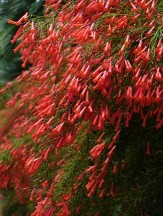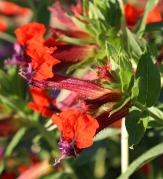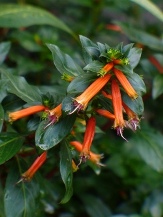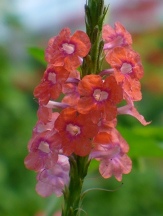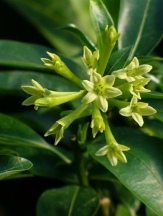Sweetly fragrant, 6" wide, clusters of deep pink flowers with deep magenta throats are held atop the dark glossy green heart-shaped foliage. The fragrant flowers attract mainly butterflies but other pollinators may show up as well. Cashmere Bouquet, Clerodendrum bungei, is an upright typically single stemmed perennial growing to about 2-4' high, occassionally to 6-8' high under freeze free conditions, and will spread vigorously if grown in the ground via underground runners creating a dense groundcover. Planted outdoors in areas where hard freezes occur, like in zones 7-9, the stems of the plant typically freeze to the ground and at the very least are typcially deciduous anywhere hard frosts occur. Cashmere Bouquet can also be enjoyed as a low maintenance container plant where it will remain more confined.
Cashmere Bouquet is tropical that acts as a dieback perennial in areas where hardy freezes occur freezing to ground level in winter and then returning in spring. If you are concerned with the plant escaping, be sure that the weep-holes of containerized plants are not in contact with the soil where it can send roots into the soil and thus become established that way. Set the pot on a concrete stepping stone or similar piece of masonry to prevent roots reaching the soil.
Grows To: 2-4'H x 1-2'W and spreading, potentially to 6-8'H under freeze free conditions
This is the average expected mature height by width in feet or inches. Feet are represented by a single quote and inches by a double quote. Parentheses are used to indicate that the plant can potentially reach that dimension, although the sizes outside of the parentheses tend to be more typical. Under poor growing conditions plants may be slightly to significantly smaller, whereas excellent growing conditions can produce larger more vigorous plants.
USDA Cold Hardiness Zones:
7,8,9,10
USDA Cold Hardiness Zones were established to give gardeners, horticulturists, farmers, nurseries, and landscape architects a universal way to describe where a plant will survive with regard to average winter lows for a region. And these are averages, here in zone 8B ('A' represents the colder half of a zone and 'B' represents the warmer half of the zone and they are separated by about 5oF) we have seen single digits but that is the exception but should be noted by the daring gardener. Each zone is separated by 10oF and the map was updated in 2012. We will continue to use the 2012 map, as the 2023 version is unrealistic. Our zones do not always agree but we try to use our own experience as to what can be depended on to return or have known reputable gardens and or horticulturists to reliably grow that plant in zones that are usually colder but sometimes warmer than what other resources have available. For more on stretching your cold hardiness zones see the ""Growing on the Edge Growing Guide". If you do not know your zone you can find it by clicking on the "USDA Cold Hardiness Zones" link here or above.
Outdoor Light: Part shade, Part sun, Bright shade, Filtered shade, Morning sun, Mostly sunny, Full sun
- Full Sun - 8 hours or more of direct sunlight;
- Mostly Sunny - about 6 hours of direct sunlight;
- Partial Shade or Part Shade - about 4 hours of direct sunlight;
- Partial Sun - about 2-4 hours of direct sunlight;
- AM Sun or Morning Sun or Cool Sunlight - cool sunlight like early in the day, like in an eastern exposure, or very late in the day but normally in the shade during the heat of the day;
- Light Shade or Bright Shade - bright indirect sunlight for much of the day;
- Filtered Shade - may receive some amount of direct moving sunlight like through trees but usually not for any extended period especially during the heat of the day;
- Shade or Deep Shade - no or very little direct sunlight, especially not during the heat of the day.
Indoor Light: Direct sunlight to high indirect sunlight are preferred if overwintering indoors
- Direct Sunlight - preferably 4 or more hours of direct sunlight through an unshaded south, east or west facing window;
- High Light - may tolerate no direct sunlight but will need very bright indirect light for 4 or more hours;
- High Indirect Light - bright indirect sunlight for much of the day;
- Medium Light - bright indirect light for 2-4 hours or more;
- Low Light - (few plants can do well under very low indoor light levels but some may tolerate it) no direct sunlight with little bright true sunlight filtering into the area;
- Cool Sunlight or Cool AM(morning) Sunlight - direct sunlight like in an east facing window but not during the heat of the day and will likely also tolerate cool sunlight late in the day, filtered sunlight may also be tolerated.
Do you know the many benefits of a proper organic mulch? Click here to learn more.
A breathable organic mulch is not only aesthetically pleasing (looks nice) but can:
- Help to improve soil organic matter as it breaks down.
- Provide shade for the soil to help reduce moisture loss and prevent weed seed germination.
- Provide soil microbes, mycorrhizae (beneficial fungi), earthworms,and even nematode predators the necessary organic matter and ecosystem to thrive while their actions aid in improving soil tilth and or friability (think of this as the ease with which roots are able to penetrate the soil).
- Provide insulation to protect the crowns of tender perennials and die-back perennials giving gardeners up to an extra half a zone of winter warmth allowing us to grow that which we normally could not.
- Provide soil temperature moderation preventing premature soil warming in winter and providing a cooler root zone in summer.
- So which mulch is our favorite? Our preferred mulch is Longleaf Pine Straw which has: a natural weed preventative for the first year after it is applied; it is sustainably harvested; and it provides protection from soil erosion and doesn't float away, and yet is still both insulative and breathable; while Longleaf Pine Straw appears to last the longest in the garden and landscape in our opinion as compared to Loblolly.
Deer Resistance: Not Normally Bothered
Deer resistance is relative to how hungry the deer (or other herbivores) are, what food is readily available in their natural habitat, and how tasty a particular plant is. Few plants are truly completely 100% resistant to being browsed by hungry deer and other herbivores. Please realize that this is just a guide based on our experience and research but some plants may never ever be bothered.Container Plant Growing Guide - includes uppotting, repotting, potting soil selection, proper watering techniques for containers, what does brown or yellow foliage and green soil indicate, and more
See our Planting A New Plant In the Garden or Landscape, How To, and General Growing Guide for basic planting, initial watering and estabishment watering in instructions
The information listed above that has a black arrow symbol, ‣, before the property name is expandable (just click on it anywhere) and it will contain additional details and a more in-depth description of the terms that we use in this plant's description. This information is based on our years of experience both gardening and growing plants, input from other horticulturists, nursery people, gardeners, and research. If you feel we are missing important information about a plant please feel free to share it with us so that we can pass it on.
![]()

